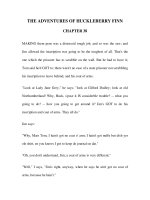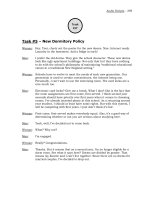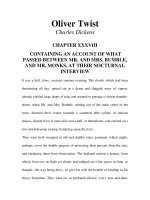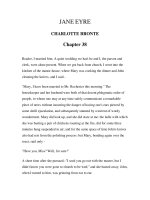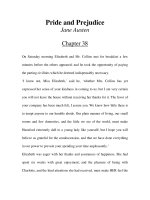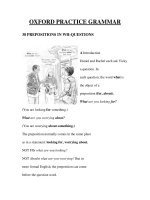38.Baker Adhesives
Bạn đang xem bản rút gọn của tài liệu. Xem và tải ngay bản đầy đủ của tài liệu tại đây (131.13 KB, 6 trang )
Baker Adhesives
In early June 2006, Doug Baker met with his sales manager Alissa Moreno to discuss
the results of a recent foray into international markets. This was new territory for
Baker Adhesives, a small company manufacturing specialty adhesives. Until a recent
sale to Novo, a Brazilian toy manufacturer, all of Baker Adhesives’ sales had been to
companies not far from its Newark, New Jersey, manufacturing facility. As U.S. man-
ufacturing continued to migrate overseas, however, Baker would be under intense
pressure to find new markets, which would inevitably lead to international sales.
Doug Baker was looking forward to this meeting. The recent sale to Novo, while
modest in size at 1,210 gallons, had been a significant financial boost to Baker Adhe-
sives. The order had used up some raw-materials inventory that Baker had considered
reselling at a significant loss a few months before the Novo order. Furthermore, the
company had been running well under capacity and the order was easily accommo-
dated within the production schedule. The purpose of the meeting was to finalize
details on a new order from Novo that was to be 50% larger than the original order.
Also, payment for the earlier Novo order had just been received and Baker was look-
ing forward to paying down some of the balance on the firm’s line of credit.
As Baker sat down with Moreno, he could tell immediately that he was in for
bad news. It came quickly. Moreno pointed out that since the Novo order was denom-
inated in Brazilian reais (BRL), the payment from Novo had to be converted into U.S.
dollars (USD) at the current exchange rate.
1
Given exchange-rate changes since the
time Baker Adhesives and Novo had agreed on a per-gallon price, the value of the
payment was substantially lower than anticipated. More disappointing was the fact
that Novo was unwilling to consider a change in the per-gallon price for the follow-
on order. Translated into dollars, therefore, the new order would not be as profitable
as the original order had initially appeared. In fact, given further anticipated changes
in exchange rates the new order would not even be as profitable as the original order
had turned out to be!
523
38
CASE
1
The Brazilian currency is referred to as real in the singular (as in “the Brazilian real”) and reais in the plural
(as in “sales are denominated in reais”).
This case was prepared by Associate Professor Marc Lipson. It was written as a basis for class discussion rather
than to illustrate effective or ineffective handling of an administrative situation. Copyright © 2007 by the Univer-
sity of Virginia Darden School Foundation, Charlottesville, VA. All rights reserved. To order copies, send an
e-mail to No part of this publication may be reproduced, stored in a
retrieval system, used in a spreadsheet, or transmitted in any form or by any means—electronic, mechanical,
photocopying, recording, or otherwise—without the permission of the Darden School Foundation. Rev. 10/10.
bru6171X_case38_523-528.qxd 12/8/12 1:26 PM Page 523
Adhesives Market
The market for adhesives was dominated by a few large firms that provided the vast
bulk of adhesives in the United States and in global markets. The adhesives giants
had international manufacturing and sourcing capabilities. Margins on most adhesives
were quite slim since competition was fierce. In response, successful firms had devel-
oped ever more efficient production systems which, to a great degree, relied on
economies of scale.
The focus on scale economies had left a number of specialty markets open for small
and technically savvy firms. The key to success in the specialty market was not the effi-
cient manufacture of large quantities, but figuring out how to feasibly and economically
produce relatively small batches with distinct properties. In this market, a good chemist
and a flexible production system were key drivers of success. Baker Adhesives had both.
The business was started by Doug Baker’s father, a brilliant chemist who left a big com-
pany to focus on the more interesting, if less marketable, products that eventually
became the staple of Baker Adhesives’ product line. While Baker’s father had retired
some years ago, he had attracted a number of capable new employees, and the com-
pany was still an acknowledged leader in the specialty markets. The production facili-
ties, though old, were readily adaptable and had been well maintained.
Until just a few years earlier, Baker Adhesives had done well financially. While
growth in sales had never been a strong point, margins were generally high and sales
levels steady. The company had never employed long-term debt and still did not do
so. The firm had a line of credit from a local bank, which had always provided
sufficient funds to cover short-term needs. Baker Adhesives presently owed about
USD180,000 on the credit line. Baker had an excellent relationship with the bank,
which had been with the company from the beginning.
Novo Orders
The original order from Novo was for an adhesive Novo was using in the production
of a new line of toys for its Brazilian market. The toys needed to be waterproof and
the adhesive, therefore, needed very specific properties. Through a mutual friend,
Moreno had been introduced to Novo’s purchasing agent. Working with Doug Baker,
she had then negotiated the original order in February (the basis for the pricing of
that original order is shown in Exhibit 1). Novo had agreed to pay shipping costs, so
Baker Adhesives simply had to deliver the adhesive in 55-gallon drums to a nearby
shipping facility.
The proposed new order was similar to the last one. As before, Novo agreed to
make payment 30 days after receipt of the adhesives at the shipping facility. Baker
anticipated a five-week manufacturing cycle once all the raw materials were in place.
All materials would be secured within two weeks. Allowing for some flexibility,
Moreno believed payment would be received about three months from order place-
ment; that was about how long the original order took. For this reason, Moreno
expected receipt of payment on the new order, assuming it was agreed upon imme-
diately, somewhere around September 5, 2006.
524 Part Seven Analysis of Financing Tactics: Leases, Options, and Foreign Currency
bru6171X_case38_523-528.qxd 12/8/12 1:26 PM Page 524
Case 38 Baker Adhesives 525
Exchange Risks
With her newfound awareness of exchange-rate risks, Moreno had gathered additional
information on exchange-rate markets before the meeting with Doug Baker. The his-
tory of the dollar-to-real exchange rate is shown in Exhibit 2. Furthermore, the data
in that exhibit provided the most recent information on money markets and an esti-
mate of the expected future (September 5, 2006) spot rates from a forecasting service.
Moreno had discussed her concerns about exchange-rate changes with the bank
when she had arranged for conversion of the original Novo payment.
2
The bank, help-
ful as always, had described two ways in which Baker could mitigate the exchange
risk from any new order: hedge in the forward market or hedge in the money markets.
Hedge in the Forward Market
Banks would often provide their clients with guaranteed exchange rates for the future
exchange of currencies (forward rates). These contracts specified a date, an amount
to be exchanged, and a rate. Any bank fee would be built into the rate. By securing
a forward rate for the date of a foreign-currency-denominated cash flow, a firm could
eliminate any risk due to currency fluctuations. In this case, the anticipated future
inflow of reais from the sale to Novo could be converted at a rate that would be known
today.
Hedge in the Money Markets
Rather than eliminate exchange risk through a contracted future exchange rate, a firm
could make any currency exchanges at the known current spot rate. To do this, of
course, the firm needed to convert future expected cash flows into current cash flows.
This was done on the money market by borrowing “today” in a foreign currency
against an expected future inflow or making a deposit “today” in a foreign account
so as to be able to meet a future outflow. The amount to be borrowed or deposited
would depend on the interest rates in the foreign currency because a firm would not
wish to transfer more or less than what would be needed. In this case, Baker Adhe-
sives would borrow in reais against the future inflow from Novo. The amount the com-
pany would borrow would be an amount such that the Novo receipt would exactly
cover both principal and interest on the borrowing.
After some discussion and negotiation with the bank and bank affiliates, Moreno
was able to secure the following agreements: Baker Adhesives’ bank had agreed to
offer a forward contract for September 5, 2006, at an exchange rate of 0.4227
USD/BRL. An affiliate of the bank, located in Brazil and familiar with Novo, was
willing to provide Baker with a short-term real loan, secured by the Novo receivable,
2
Though Baker Adhesives had a capable accountant, Doug Baker had decided to let Alissa Moreno handle
the exchange-rate issues arising from the Novo order until they better understood the decisions and tradeoffs
that needed to be made.
bru6171X_case38_523-528.qxd 12/8/12 1:26 PM Page 525
at 26%.
3
Moreno was initially shocked at this rate, which was more than three times
the 8.52% rate on Baker’s domestic line of credit; however, the bank described Brazil’s
historically high inflation and the recent attempts by the government to control infla-
tion with high interest rates. The rate they had secured was typical of the market at
the time.
The Meeting
It took Doug Baker some time to get over his disappointment. If international sales
were the key to the future of Baker Adhesives, however, Baker realized he had already
learned some important lessons. He vowed to put those lessons to good use as he and
Moreno turned their attention to the new Novo order.
526 Part Seven Analysis of Financing Tactics: Leases, Options, and Foreign Currency
3
Note that the loan from the bank affiliate was a 26% annual percentage rate for a three-month loan
(the bank would charge exactly 6.5% on a three-month loan, to be paid when the principal was repaid).
The effective rate over three months was, therefore, 6.5%. The 8.52% rate for Baker’s line of credit was an
annual percentage rate based on monthly compounding. The effective monthly rate was, therefore,
8.52% Ϭ 12 ϭ 0.71%, which implies a (1.0071)
3
Ϫ 1 ϭ 2.1452% effective rate over three months.
bru6171X_case38_523-528.qxd 12/8/12 1:26 PM Page 526
EXHIBIT 1 | Novo Price Calculation on Initial Order
(figures in U.S. dollars unless otherwise specified)
Labor 6,000
Materials 32,500
Manufacturing overhead 4,000
Administrative overhead 2,000
Total costs 44,500
Profit margin (12%) 6,068
Cost plus profit margin in dollars 50,568
Conversion (USD/BRL) 0.4636
Cost plus markup (BRL) 109,077
Amount (gallons) 1,210
Quoted price per gallon (BRL) 90.15
Notes:
The exchange rate used in the calculation was obtained from the
Wall Street Journal
.
Overhead was applied based on labor hours.
The raw materials expense was based on the original cost (book value) of the materials.
The rounded price of BRL90.15 per gallon was used in negotiations with Novo. Thus, for the final order,
Novo was billed a total of BRL90.15 ϫ 1,210 ϭ BRL109,081.50.
Source: Created by case writer.
Case 38 Baker Adhesives 527
bru6171X_case38_523-528.qxd 12/8/12 1:26 PM Page 527
EXHIBIT 2 | Exchange Rate and Money-Market Information
Exchange Rates for the Real as of June 5, 2006 (USD/BRL)
Bid on real 0.4368
Ask for real 0.4371
Consensus forecast bid for September 5, 2006 0.4234
Consensus forecast ask for September 5, 2006 0.4239
Standard Deviation of Monthly Exchange-Rate Changes
2005 3.36%
Year to date 2006 6.53%
Interbank Rates (annual effective rates)
Brazil 19.47%
United States 5.08%
Data Source:
Wall Street Journal
.
Source: Created by case writer.
Bid on Real
0.3000
0.3200
0.3400
0.3600
0.3800
0.4000
0.4200
0.4400
0.4600
0.4800
0.5000
1/1/2005
2/1/2005
3/1/2005
4/1/2005
5/1/2005
6/1/2005
7/1/2005
8/1/2005
9/1/2005
10/1/2005
11/1/2005
12/1/2005
1/1/2006
2/1/2006
3/1/2006
4/1/2006
5/1/2006
6/1/2006
Date
Dollar Value of Real
(US$/BRL)
528 Part Seven Analysis of Financing Tactics: Leases, Options, and Foreign Currency
bru6171X_case38_523-528.qxd 12/8/12 1:26 PM Page 528
